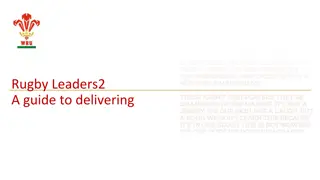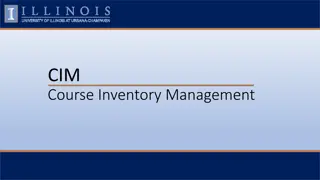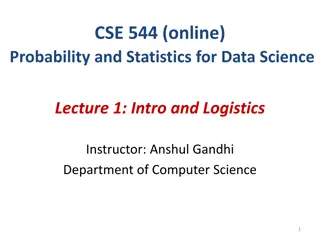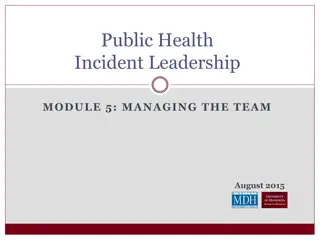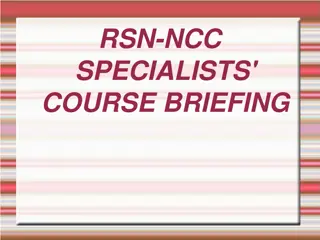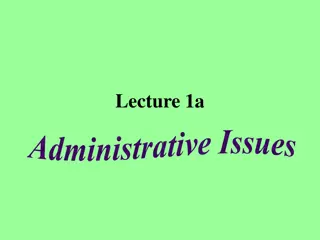Overall Course Objectives
Participants in this course will discuss advances in social norms programming, explore norms-shifting interventions, and learn about monitoring and evaluating normative shifts in complex environments. The session will cover data gathering approaches, types of measures for evaluating social norms, and adaptation of monitoring and evaluation systems for norm-focused projects.
Download Presentation

Please find below an Image/Link to download the presentation.
The content on the website is provided AS IS for your information and personal use only. It may not be sold, licensed, or shared on other websites without obtaining consent from the author.If you encounter any issues during the download, it is possible that the publisher has removed the file from their server.
You are allowed to download the files provided on this website for personal or commercial use, subject to the condition that they are used lawfully. All files are the property of their respective owners.
The content on the website is provided AS IS for your information and personal use only. It may not be sold, licensed, or shared on other websites without obtaining consent from the author.
E N D
Presentation Transcript
MODULE 4 | MEASURING NORMATIVE SHIFTS IN COMPLEX ENVIRONMENTS Overall Course Objectives 1. Discuss and explore advances in social norms programming, the relation of norms-shifting interventions to behavior change efforts, and the role of social norms in health and other sector programming. 2. Share design, implementation, and evaluation challenges and solutions for community-based social and behavior change (SBC) projects engaging in, expanding, or planning to expand normative change efforts. 3. Explore next steps to further collective learning about such promising interventions globally. Shifting Social Norms as Part of SBC
MODULE 4 | MEASURING NORMATIVE SHIFTS IN COMPLEX ENVIRONMENTS Overview Measuring Social Norms Learning Objectives During this session, participants will: 1. Identify core elements of monitoring and learning to gauge and address signs of norms shifting at the program level. 2. Distinguish among data gathering approaches, including types of indicators, for activity monitoring to track shifts in norms, diffusion effects, and the quality of implementation. 3. Review and examine types of measures to use in baseline and endline evaluations of social norms. 4. Use a case study to practice adapting a monitoring, evaluation, and learning (MEL) system of a norms-focused social and behavior change (SBC) project.
MODULE 4 | MEASURING NORMATIVE SHIFTS IN COMPLEX ENVIRONMENTS Monitoring and Evaluation (M&E) of NSI TYPICAL PROGRAM FOR NSI OPERATING IN COMPLEX SOCIAL ENVIRONMENTS Develop understanding of whether program elements are being implemented as designed, complementing each other, moving together to support change. Track expected and unexpected social change effects (individual change of early adapters, social opposers, and collective actions). Data and insights from monitoring may inform program evaluation and learning about the program. Monitoring Data and insights from evaluation may inform how well an SBC program is working and future implementation of programs. The extent to which normative shifts occur should be reflected in baseline and endline evaluations. Focus on which norms are being explicitly addressed and what level of normative change is expected by project end. Evaluation Learning as Part of M&E Flexible, exploratory, iterative way to integrate observations and emerging knowledge into a program on an ongoing basis. Regular cycles of learning. Recognizes that staff close to a program have the best knowledge of circumstances. Uses monitoring and learning to adjust programs as they are being implemented to put learning into program action.
MODULE 4 | MEASURING NORMATIVE SHIFTS IN COMPLEX ENVIRONMENTS Added NSI Measurement Moments STAGE LEARNING AIMS METHODS Identify possible social norms, sanctions, reference groups. Formative assessment Literature review, community discussions. Activity monitoring, direct/indirect observation, rapid studies to test strategies. Observe signs of norms change, monitor backlash. Monitoring Baseline: verify social norms, norm strength, identify cracks in norms and opportunities for intervention. Endline: changes in social norms; correlates with attitudes and behaviors. Quantitative surveys and qualitative interviews and discussions using vignettes and norms-oriented questions. Evaluation of impact Signs of Norms Shifts to Monitor INITIAL SIGNS OF CHANGE EXPLANATION When a practice is a social norm, people believe that most other people follow the norm. If people start to believe that it s become common not to follow the norm, this change can indicate the norm is shifting. A norm is no longer common. When a practice is a social norm, people believe that others will disapprove if they do not follow the norm. Changes in these perceptions can indicate a norm is shifting. A norm is no longer approved of. Social norms are shared beliefs about which behaviors are common and appropriate within a group. If individuals beliefs start to differ from one another there is no longer consensus about a norm it can indicate a norm is shifting. There is no longer consensus around a norm.
MODULE 4 | MEASURING NORMATIVE SHIFTS IN COMPLEX ENVIRONMENTS Monitoring Methods and Approaches METHODS TOOLS & APPROACHES Activity monitoring. Monitoring systems with norms change indicators. Observation by frontline workers and field supervisors. Rapid studies to test new strategies. Qualitative methods (e.g., interviews, focus groups). Periodic guided-learning reflections with staff. Community-led surveillance of signs of norms change (e.g., program feedback). Periodic check-ins with community monitors. Monitoring Diffusion in Norms- Shifting Programs NSIs can have planned diffusion strategies, and diffusion also happens outside of project outputs, in unpredictable ways, especially for social change. Hence, diffusion of norms change is complex and difficult to track through routine program monitoring. Programs with organized diffusion as a strategy can monitor the ways they expect those changes to unfurl, which can help teams understand norms shifting over time when combined with evaluation research.
MODULE 4 MEASURING NORMATIVE SHIFTS IN COMPLEX ENVIRONMENTS Strategy Testing Using Learning Agendas Learning agendas can help guide learning on a range of implementation issues and needed adjustments: Testing of existing or new strategies. Strategies ease of implementation. How beneficiaries appreciate (or not) the NSI strategy. Whether activities are leading to expected social, behavioral, structural, or other shifts. GROUP DISCUSSION Learning Agendas 1. Have you ever used learning agendas to focus gathering information to monitor project implementation and social change? What were benefits and challenges? 2. Given the intangible nature of social change (that is, social change is not easily countable), what kinds of monitoring and rapid studies were or could be done? And by whom? What might be challenges?
MODULE 4 | MEASURING NORMATIVE SHIFTS IN COMPLEX ENVIRONMENTS Individual vs. Social Norm Measures TYPE OF MEASURE MEASURING EXAMPLE QUESTION Individual measures Should people your age wear face masks In public? Attitude Is wearing face masks in public typical among adults in your community? Descriptive norm Social norm measures Is wearing face masks in public approved of among adults in your community? Injunctive norm Characteristics of a Promising Social Norms Measure 1. Is specific about a concrete scenario and expected outcome. 2. Refers to specific behaviors. 3. Refers to a reference group. If not, it s an individual attitude. 4. Measures both injunctive and descriptive norms. 5. Determines whether sanctions exist and how much they matter. 6. May take different forms. 7. May measure collective norms (aggregated attitudes rather than perceived norms).
MODULE 4 | MEASURING NORMATIVE SHIFTS IN COMPLEX ENVIRONMENTS Scales PERCENT OF THE COMMUNITY So me Most/al l Item None A husband who helps his wife with the household chores will not be respected by his family. 32 37 31 A man who makes important decisions jointly with his wife will be considered a weak man by his family. 31 42 28 A man s family will think he is a disloyal son if he takes his wife s opinion over his mother s opinion. 18 43 39 A woman who openly expresses her sexual desires to her husband is perceived to be vulgar. 34 38 28 Single Item Now I would like to know what people in your congregation actually do. Think about what is normal or typical behavior when you respond to these statements. Do you think that these statements are true for most, many, some, or none of the newly married couples or first-time parents in this congregation? None ...1 Some ...2 Many .. .3 Most ...4 A husband beats his wife.
MODULE 4 | MEASURING NORMATIVE SHIFTS IN COMPLEX ENVIRONMENTS Vignettes Desired Target Behavior: Parents talk to their very young adolescents (VYA) about puberty. 1. What are the factors that support this behavior? Which ones are socio-cultural? 2. Identified social norm behavior: Normative behavior you would like to shift, e.g., parents not talking about puberty to VYAs. Descriptive norms: Perceptions about what is common behavior. 3. In your opinion, how many people practice this behavior? [ few | some | many | most ] 4. What are the advantages of practicing this behavior? What are the disadvantages? a. How many see this as advantageous? [ few | some | many | most ] b. Are these advantages/disadvantages stronger for some community groups than other groups? Injunctive norms: Perceptions about what other people think is approved behavior. 5. How many people in your community approve of this behavior? [ few | some | many | most ] 6. What happens if you do not practice this behavior? a. How many in your community would sanction people if they did not practice the behavior? b. Are these sanctions stronger for some community groups than other groups? VIGNETTES RESPONSES Child Marriage Father and mother make every decision about marriage. It is not acceptable that one should marry on her own wish. (descriptive norm) Parents make the decision in order to avoid any bad rumor in the society concerning the girl. (injunctive norm) Her mother tells [her] that if she does that (follows her own wishes), the neighbors would backbite about her and would laugh at [her]. (sanctions on the girl)
MODULE 4 | MEASURING NORMATIVE SHIFTS IN COMPLEX ENVIRONMENTS Key Takeaways Measure either the descriptive norm (perceptions of typical behavior) or injunctive norm (perceptions of what is appropriate) or ideally both. Refer to a reference group. If not, it s an individual attitude. Use an approach best-suited to respondents (i.e., single item, scales or indices, vignettes, other participatory methods). Social change is complex; monitoring and evaluation methods need to address complexity. Collect and use data in real time to guide implementation. Strengthen adaptive capacity and build a culture of adaptive management to foster norms change Resources Map of social norms-focused projects and their measurement approaches: Who is doing what and where. ALiGN: Advancing Learning and Innovation on Gender Norms. Overseas Development Institute (ODI), 2002. https://www.alignplatform.org/learning-collaborative/case-studies Passages Project and the Social Norms Learning Collaborative. Social Norms Exploration Tool. Washington, DC: Institute for Reproductive Health, Georgetown University, 2020. https://irh.org/social-norms-exploration/ Passages Project. Costing of Norms-Shifting Interventions: A Primer from the Passages Project. Washington, D.C.: Institute for Reproductive Health, Georgetown University for the U.S. Agency for International Development (USAID), 2020. https://www.alignplatform.org/resources/costing-norms-shifting- interventions-primer-passages-project The Social Norms Learning Collaborative. Resources for Measuring Social Norms: A Practical Guide for Program Implementers. Washington, DC: Institute for Reproductive Health, Georgetown University, 2019. https://www.alignplatform.org/resources/resources-measuring-social-norms-practical-guide- programme-implementers Center on Gender Equity and Health. Evidence-based Measures of Empowerment for Research on Gender Equality (EMERGE). University of California, San Diego, 2020. https://emerge.ucsd.edu/ The Social Norms Learning Collaborative. Monitoring Shifts in Social Norms: A Guidance Note for Program Implementers. Washington, DC: 2021. https://www.alignplatform.org/resources/monitoring- shifts-social-norms-guidance-note-program-implementers











